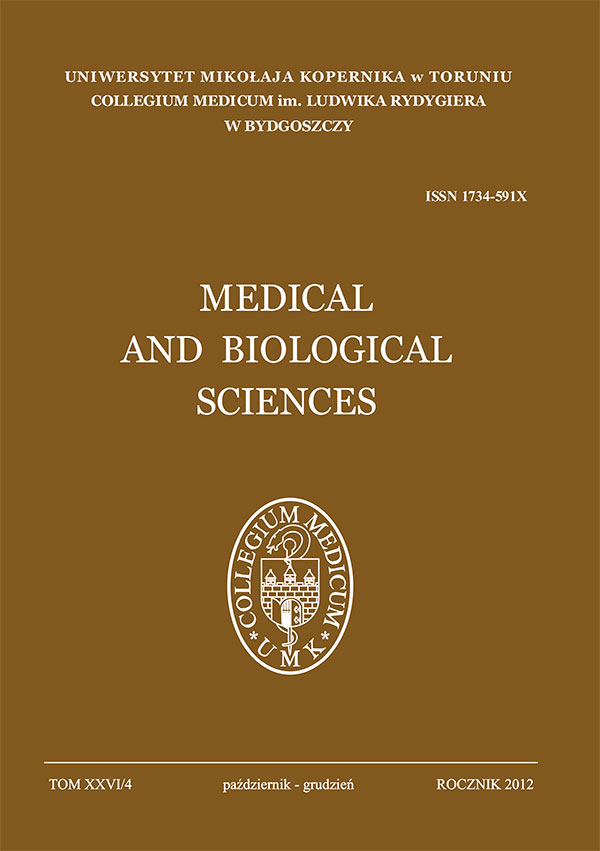Addison’s disease due to tuberculosis of the adrenal glands – case report and review of the literature
DOI:
https://doi.org/10.12775/v10251-012-0071-1Keywords
Addison’s disease, adrenal gland tuberculosisAbstract
Introduction. Addison’s disease (AD) or primary adrenocortical insufficiency was first described by Thomas Addison in patients with adrenal tuberculosis (TBC). Over the past several decades, along with the introduction of antituberculous chemotherapy, the incidence of TBC and AD have declined. The most common symptoms are nonspecific, therefore diagnosis is often delayed and patients may first present with a life-threatening crisis. In this report we present a case of newly diagnosed Addison's disease due to tuberculosis of the lungs and both adrenal glands, endured many years ago, with a life-threatening crisis in the past history.
Case report. A 75-year-old man was admitted to our hospital because of weakness, nausea, lack of appetite, low blood pressure, postural hypotension and electrolyte disturbances. The first symptoms appeared 20 years ago; at that time he had been cured because of lung tuberculosis. One month before he was admitted to Department of Endocrinology, he had had an episode of cardiac arrest during attempt of laparoscopic cholecystectomy. The diagnosis towards Addison's disease has been made. Based on the past history of TBC, clinical symptoms, laboratory results and CT features we could confirm an initial diagnosis of primary adrenocortical failure due to tuberculosis of the adrenal glands. As a result of applied replacement therapy, we gained improvement of patient's condition.
Conclusion. Although tuberculous Addison’s disease has been decreasing markedly in recent years, the possibility of adrenal insufficiency should be considered when weight loss, gastrointestinal symptoms, hyponatraemia and hyperkalaemia are observed in patients with active tuberculosis or in those having a past history of TBC.
References
Addison T. On the constitutional and local effects of disease of the supra-renal capsules. London: Highley, 1855.
Patnaik MM, Deshpande AK. Diagnosis-Addison’s disease secondary to tuberculosis of the adrenal glands. Clin Med Res 2008; 6(1): 29. [ http://dx.doi.org/10.3121/cmr.2007.754a]
Brooke AM, Monson JP. Addison’s disease. Medicine 2009; 37(8): 416-419. [ http://dx.doi.org/10.1016/j.mpmed.2009.05.006]
Kinjo T, Higuchi D, Oshiro Y et al. Addison’s disease due to tuberculosis that required differentiation from SIADH. J Infect Chemother 2009; 15(4): 239-242. [ http://dx.doi.org/10.1007/s10156-009-0690-z]
Lam KY, Lo CY. A critical examination of adrenal tuberculosis and a 28-year autopsy. Clin Endocrinol (Oxf) 2001; 54(5): 633-639. [ http://dx.doi.org/10.1046/j.1365-2265.2001.01266.x]
Ma ES, Yang ZG, Li Y et al. Tuberculous Addison’s disease: Morphological and quantitative evaluation with multidetector-row CT. Eur J Radiol 2007; 62(3): 352-358. [ http://dx.doi.org/10.1046/j.1365-2265.2001.01266.x]
Bhatia E, Jain SK, Gupta RK et al. Tuberculous Addison's disease: lack of normalization of adrenocortical function after anti-tuberculous chemotherapy. Clin Endocrinol (Oxf) 1998; 48(3): 355-359. [ http://dx.doi.org/10.1046/j.1365-2265.1998.00409.x]
Guo YK, Yang ZG, Li Y et al. Addison’s disease due to adrenal tuberculosis: contrast-enhanced features and clinical duration correlation. Eur J Radiol 2007; 62(1): 126-131. [ http://dx.doi.org/10.1016/j.ejrad.2006.11.025]
Yokoyama T, Toda R, Kimura Y et al. Addison’s disease induced by miliary tuberculosis and the administration of rifampicin. Inter Med 2009; 48(15): 1297-1300. [ http://dx.doi.org/10.2169/internalmedicine.48.1974]
Zhang XC, Yang ZG, Li Y et al. Addisons disease due to adrenal tuberculosis: MRI features. Abdom Imaging 2008; 33(6): 689-694. [ http://dx.doi.org/10.1007/s00261-007-9352-8]
Jacobi J, Schnellhardt S, Kulschewski A et al. An unusual case of hyponatraemia. Nephrol Dial Transplant 2010; 25(3): 998-1001.
Nomura K, Demura H, Saruta T. Addison’s disease in Japan: characteristics and changes revealed in a nationwide survey. Intern Med 1994; 33(10): 602-606. [ http://dx.doi.org/10.2169/internalmedicine.33.602]
Dorin RI, Qualls CR, Crapo LM. Diagnosis of adrenal insufficiency. Ann Intern Med 2003; 139(3):194-204. [ http://dx.doi.org/10.7326/0003-4819-139-3-200308050-00017]
Alevritis EM, Sarubbi FA, Jordan RM et al. Infectious causes of adrenal insufficiency. South Med J 2003; 96 (9): 888-891. [ http://dx.doi.org/10.1097/01.SMJ.0000073269.49575.DF]
Soule S. Addison;s disease in Africa- a teaching hospital experience. Clin Endocrinol (Oxf) 1999, 50(1): 115-120. [ http://dx.doi.org/10.1046/j.1365-2265.1999.00625.x]
Efremidis SC, Harsoulis F, Douma S et al. Adrenal insufficiency with enlarged adrenals. Abdom Imag 1996; 21(2):168-171. [ http://dx.doi.org/10.1007/s002619900037]
Yang ZG, Guo YK, Li Y et al. Differentiation between tuberculosis and primary tumors in the adrenal gland: evaluation with contrast-enhanced CT. Eur Radiol 2006; 16(9): 2031-2036. [ http://dx.doi.org/10.1007/s00330-005-0096-y]
Wang YX, Chen CR, He GX et al. CT findings of adrenal glands in patients with tuberculous Addison’s disease. J Belge Radiol 1998; 81(5): 226-228.
Kelestimur F. Recovery of adrenocortical function following treatment of tuberculous Addison's disease. Postgrad Med J 1993; 69(816): 832- 834.
Downloads
Published
How to Cite
Issue
Section
Stats
Number of views and downloads: 502
Number of citations: 0



